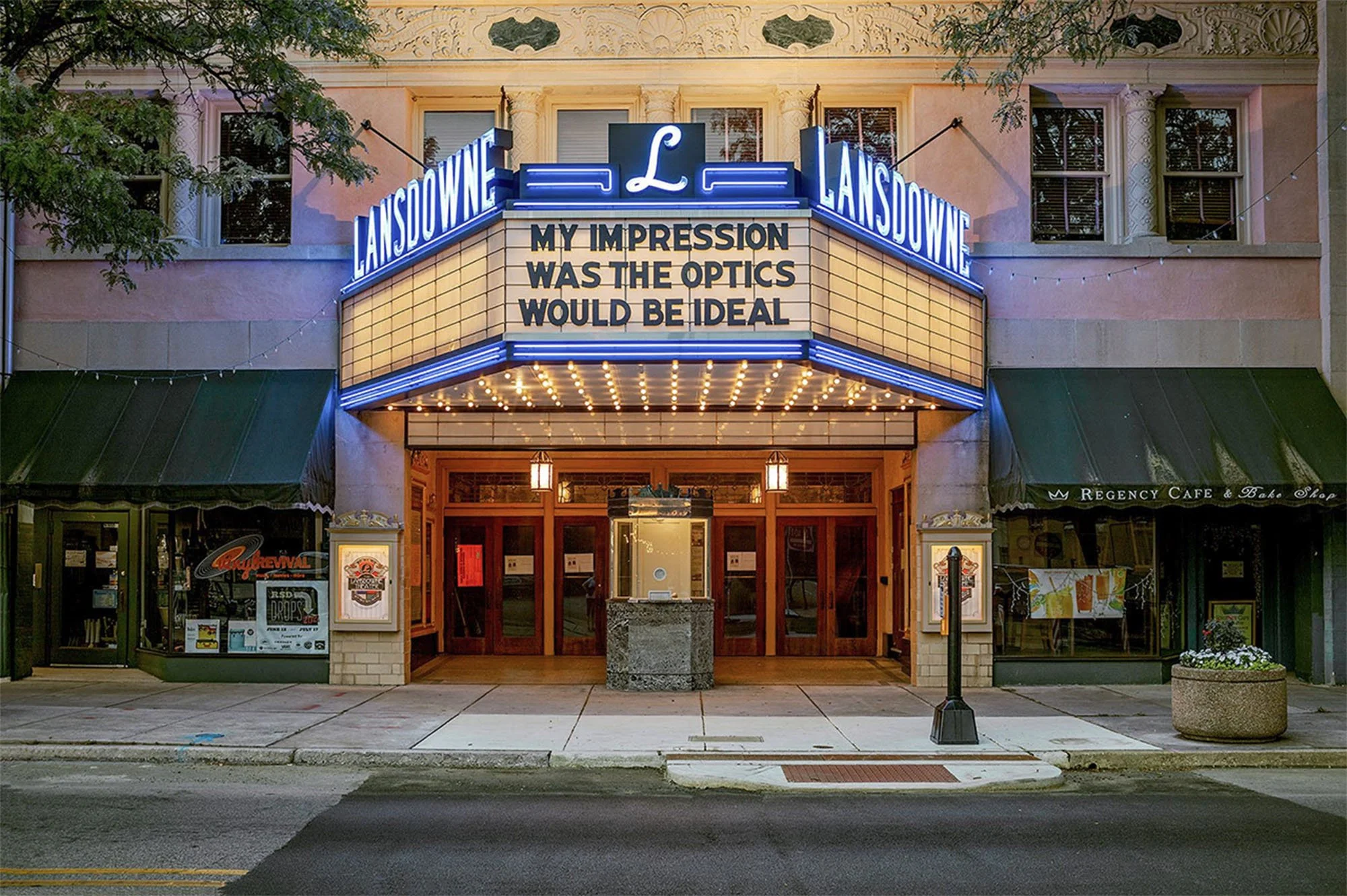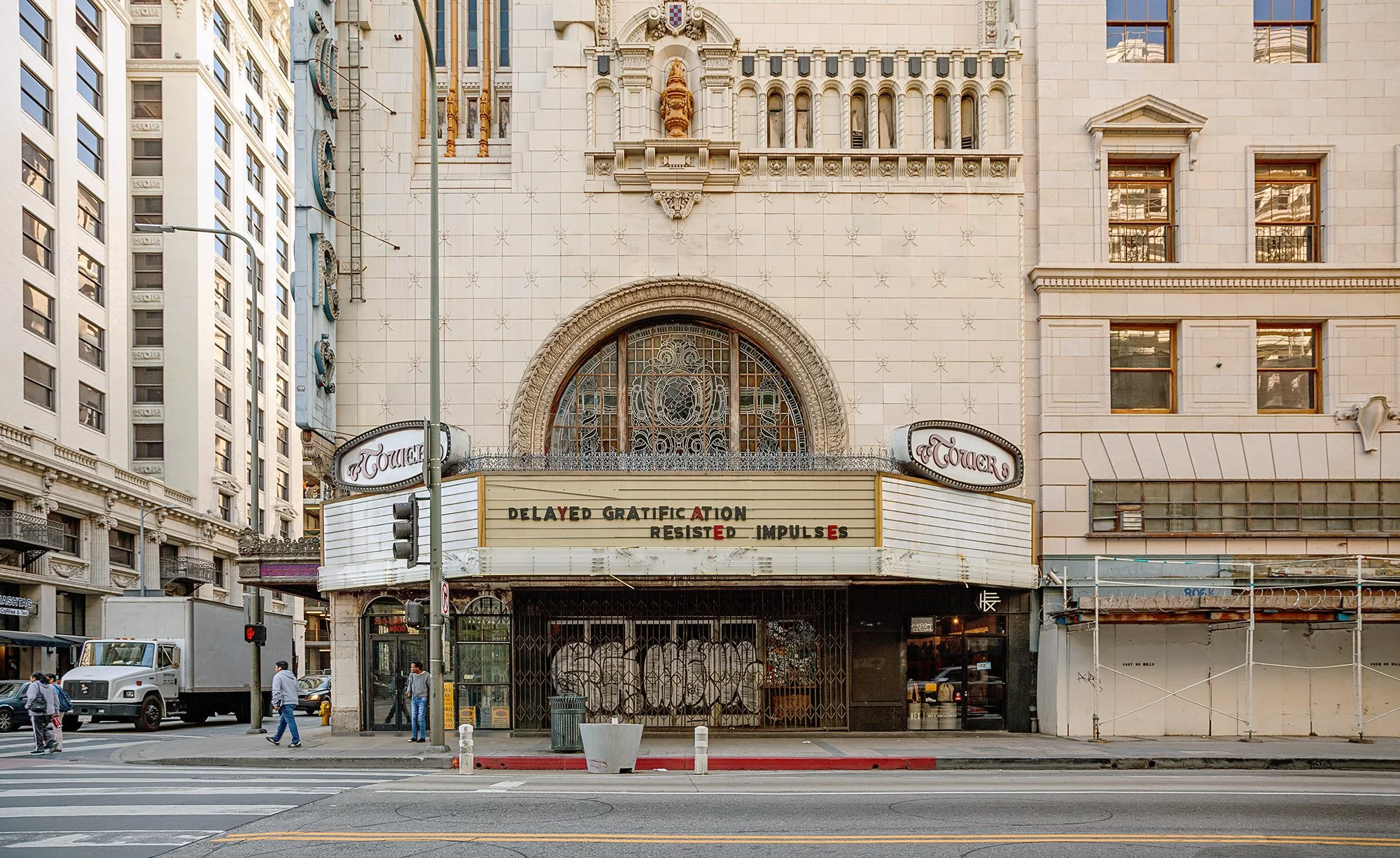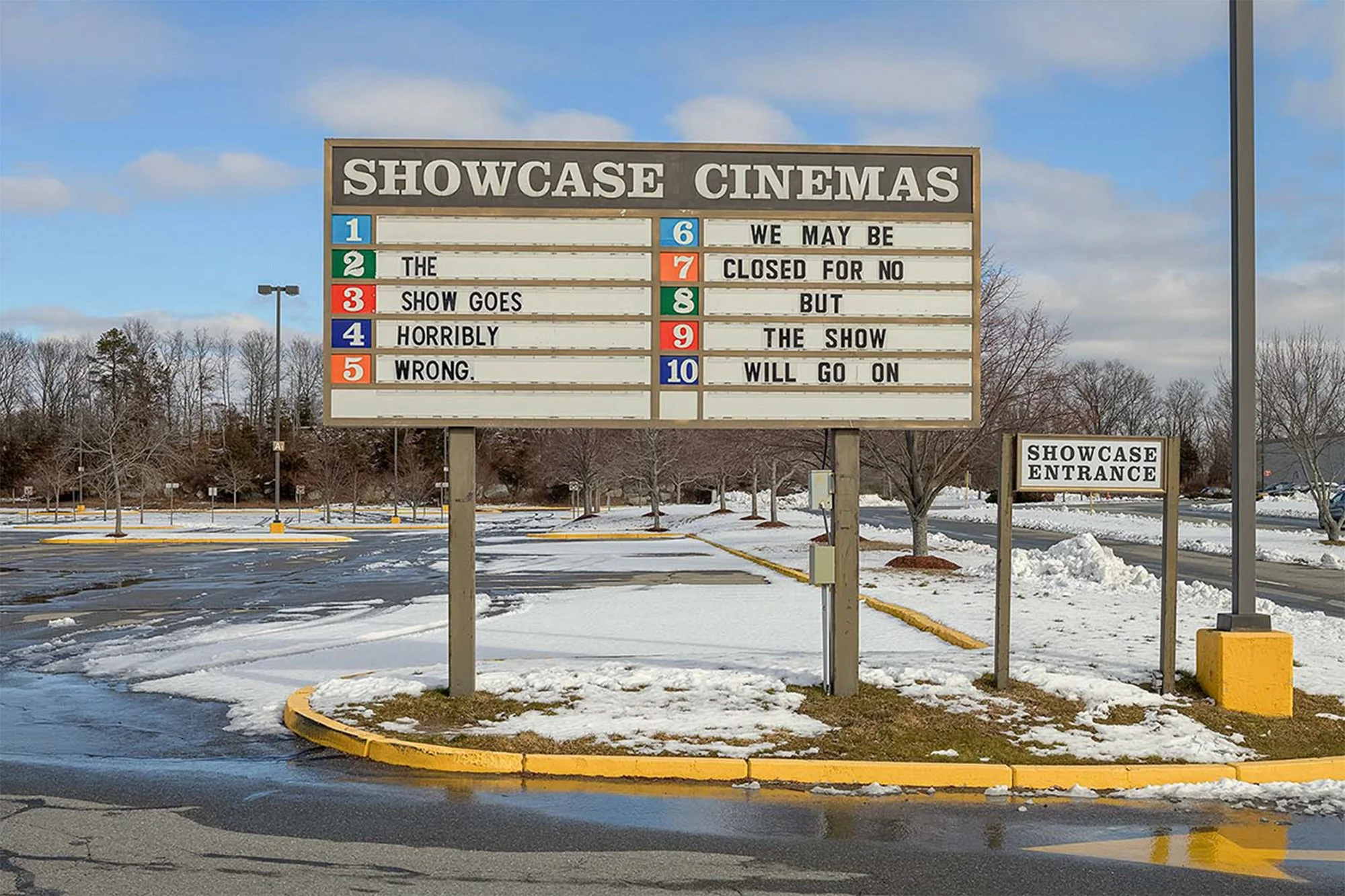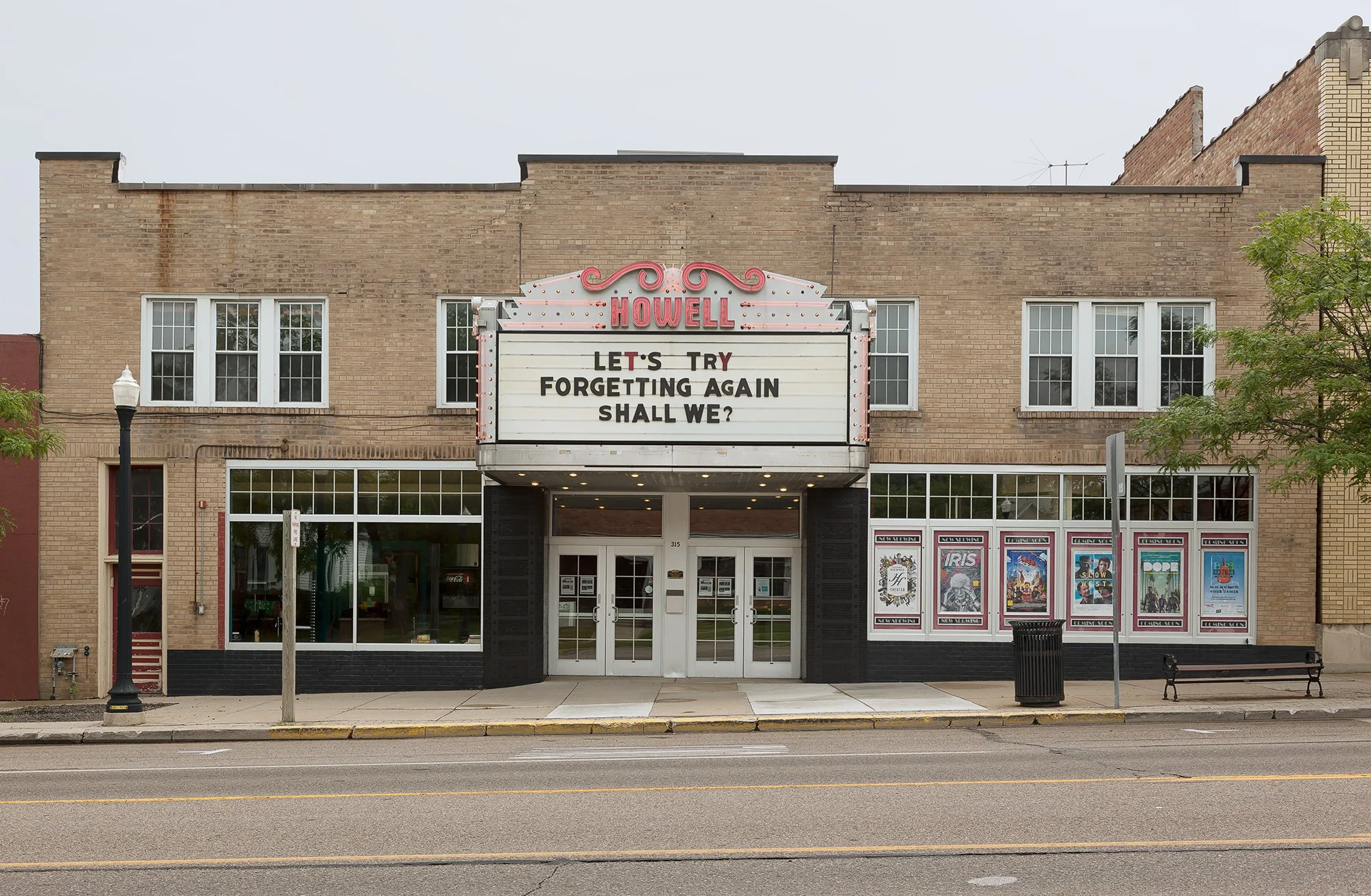Victoria Crayhon
Untitled Lansdowne PA 2021. Archival Pigment Print 30 x 44 inches. All images courtesy of the artist.
Text and Images by Victoria Crayhon
Interview by Ora Heard
How did your series Thoughts on Romance on the Road come to be?
Thoughts on Romance on the Road began with my twice weekly commute to a teaching job in Vermont right after grad school. My route was partly on an older highway and passed a shuttered drive-in movie theater with a double marquee atop a big stone entryway. I thought why not get some letters that would fit there and start writing personal stuff on it? It was a natural progression from my work in grad school, where I placed printed texts on billboards and left them up after shooting a large format photograph.
In this case, I didn’t initially want to leave my texts up after making the image because the letters were expensive back then and I didn’t have so many. That changed once I found a place to order them in bulk.
Untitled I Los Angeles CA 2017. Archival Pigment Print, 44 x 60 inches
Did the location of each installment have any influence over what text you decided to put up?
If you mean the geographical location having influence on the writing, no. I search for usable theaters everywhere and will drive as far as needed to get to them.
If by location, you mean the theaters themselves, then yes. Sometimes I have a piece of writing ready and I search for an appropriate theater to put it on. I’m fairly picky about what theaters or marquees I can use. They must be visible from the road; the marquees can’t be overly decorative or distracting nor have any kind of sharp angle that would be difficult to see on a 2D surface. The marquee area needs to be big and in good enough shape that it can hold the letters. I’ll place longer texts on bigger double-sided signs, for shorter one-liners I tend to use the single screen flat signs.
If I don’t have a piece of writing ready and a sign is particularly unique, I will write/design something specific for it. A good example would be the moving LED sign at the Beverly Theater. (Untitled I and II, Beverly MA), where I did an all-night digital installation consisting of 4 separate text screens looped on a double marquee.
On other occasions I make texts that are designed work with whatever is already present in the shot. The word “Telephones” on a motel marquee in Vegas, for example, I paired with “I Remember You.” Or the installation I did during covid in Seekonk MA, 2021, when theaters were closed, and it was a good opportunity to use a working commercial theater sign. There was text already there saying (I’m paraphrasing here) “the show will go on when we can all be together again” and I couldn’t resist working right alongside that, rather than removing it.
Untitled I Beverly MA 2016. Archival Pigment Print 40 x 50 inches
Untitled II Beverly MA 2016. Archival Pigment Print 40 x 50 inches
Were there any challenges that came up when creating these images?
Yes, how about a list? In no particular order: Police. Security detail people. Traffic. Tattletales driving by calling the police or security detail. Ticks. Bird shit. Wind. Temperature. Camera freezing. Risk of getting hit by other cars. Letters falling down after I placed them and moved ladder for the shot. Getting rid of visual obstructions like branches or cars. Finding theatre owners. Marquees that are too high and/or broken and can’t support a ladder, forcing me to bust out the mechanical hand, which, when fully extended, has serious arm injury potential. Just a few challenges.
Things are a lot smoother and more fun when I have an assistant, but I didn’t always have one. Often, I/we would have to wait hours for cars to move or the daylight to change. I try to shoot only on overcast days but in some places (Los Angeles or Las Vegas for example) that’s not a viable option, so the sun needs to be behind me. If I’m in a city with a lot of traffic I work early in the morning. I do a lot of reconnaissance for each site, the first things I look at are the marquee slot size for the letters and then the parking signs.
Usually there’s a small window of time when things are quiet and the street is empty. If the light is bad in early morning, I use flash. Since I switched to digital cameras, I’m able to work a lot faster and shoot video at the same time.
Untitled II Seekonk MA 2021. Archival Pigment Print 30 x 44 inches
Have you ever gone back to visit a location after you've taken your image to see if your work was still there?
Yes, almost always. But if I’ve done the sign while on a road trip and had to leave right away, then no. Often, friends in the area will send me photos after I’ve gone.
I have to say I really love the idea of people I don’t know taking photos of my sign installations and keeping them as their own photographs. It’s like they become part of the process by continuing the life of the work and making it separate from myself.
Untitled III Providence RI 2005. Archival Pigment Print 24 x 36 inches
Describe your creative process in one word?
Super hard question. I would need about 5 words, but I’ll go with this one: Writing.
What inspires you to pursue image-making?
I’m searching for something I suppose. More for questions than answers.
Untitled II Holland MI 2015. Archival Pigment Print 24 x 36 inches
What was the last book you read or film you saw that inspired you?
I recently read the novel Demon Copperhead by Barbara Kingsolver and I couldn’t put it down for anything. It’s about so many pressing issues in America right now and the main character is so compelling that I actually miss him since I’ve finished the book.
I highly recommend it.
Untitled Howell MI 2015. Archival Pigment Print 24 x 36 inches.
What advice would you give to people just starting out in photography?
Look at a lot of artwork, spend less time using social media, go out in the world, read books, talk to humans, get out of your comfort zone. Try to get as much feedback on your work as you can but always be making new work. Apply for stuff. Meet regularly with your peers. Be disciplined about spending time on your own photography. Be aware of what’s happening in the world, don’t live in a bubble.
Untitled IV Quincy MA 2014. Archival Pigment Print 24 x 36 inches
What is your favorite podcast to listen to?
I listen to books and articles more than actual podcasts, although I suppose the Ezra Klein show would be one I do play on the regular. Audio book-wise, though, I’ve been obsessed with anything by Patrick Radden Keefe, Timothy Snyder, and Masha Gessen.
Untitled Lowell MI 2014. Archival Pigment Print 24 x 36 inches

















